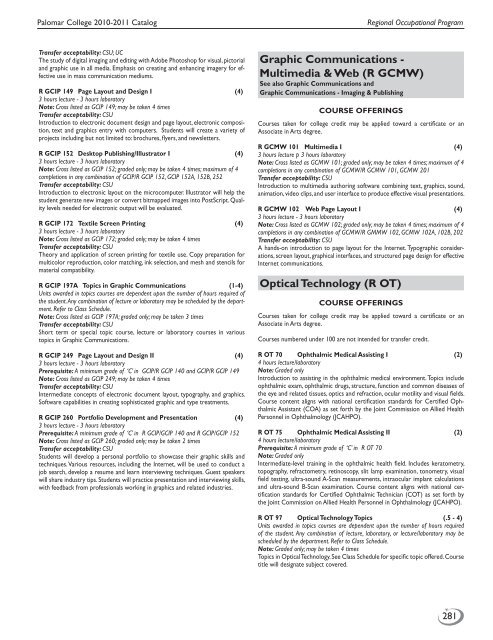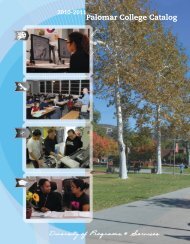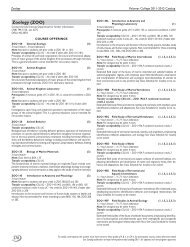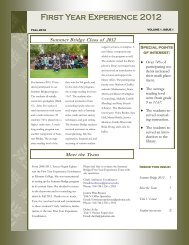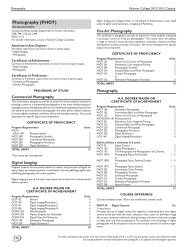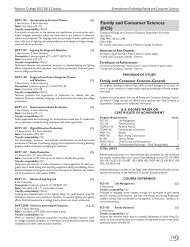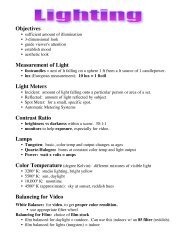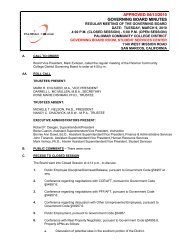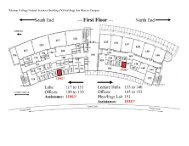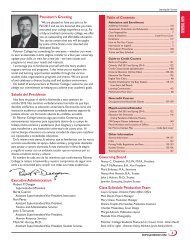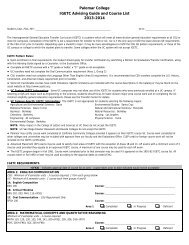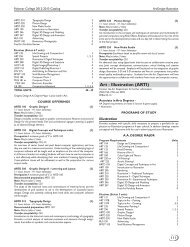Download the complete catalog - Palomar College
Download the complete catalog - Palomar College
Download the complete catalog - Palomar College
You also want an ePaper? Increase the reach of your titles
YUMPU automatically turns print PDFs into web optimized ePapers that Google loves.
<strong>Palomar</strong> <strong>College</strong> 2010-2011 Catalog<br />
Regional Occupational Program<br />
Transfer acceptability: CSU; UC<br />
The study of digital imaging and editing with Adobe Photoshop for visual, pictorial<br />
and graphic use in all media. Emphasis on creating and enhancing imagery for effective<br />
use in mass communication mediums.<br />
R GCIP 149 Page Layout and Design I (4)<br />
3 hours lecture - 3 hours laboratory<br />
Note: Cross listed as GCIP 149; may be taken 4 times<br />
Transfer acceptability: CSU<br />
Introduction to electronic document design and page layout, electronic composition,<br />
text and graphics entry with computers. Students will create a variety of<br />
projects including but not limited to: brochures, flyers, and newsletters.<br />
R GCIP 152 Desktop Publishing/Illustrator I (4)<br />
3 hours lecture - 3 hours laboratory<br />
Note: Cross listed as GCIP 152; graded only; may be taken 4 times; maximum of 4<br />
completions in any combination of GCIP/R GCIP 152, GCIP 152A, 152B, 252<br />
Transfer acceptability: CSU<br />
Introduction to electronic layout on <strong>the</strong> microcomputer. Illustrator will help <strong>the</strong><br />
student generate new images or convert bitmapped images into PostScript. Quality<br />
levels needed for electronic output will be evaluated.<br />
R GCIP 172 Textile Screen Printing (4)<br />
3 hours lecture - 3 hours laboratory<br />
Note: Cross listed as GCIP 172; graded only; may be taken 4 times<br />
Transfer acceptability: CSU<br />
Theory and application of screen printing for textile use. Copy preparation for<br />
multicolor reproduction, color matching, ink selection, and mesh and stencils for<br />
material compatibility.<br />
R GCIP 197A Topics in Graphic Communications (1-4)<br />
Units awarded in topics courses are dependent upon <strong>the</strong> number of hours required of<br />
<strong>the</strong> student. Any combination of lecture or laboratory may be scheduled by <strong>the</strong> department.<br />
Refer to Class Schedule.<br />
Note: Cross listed as GCIP 197A; graded only; may be taken 3 times<br />
Transfer acceptability: CSU<br />
Short term or special topic course, lecture or laboratory courses in various<br />
topics in Graphic Communications.<br />
R GCIP 249 Page Layout and Design II (4)<br />
3 hours lecture - 3 hours laboratory<br />
Prerequisite: A minimum grade of ‘C’ in GCIP/R GCIP 140 and GCIP/R GCIP 149<br />
Note: Cross listed as GCIP 249; may be taken 4 times<br />
Transfer acceptability: CSU<br />
Intermediate concepts of electronic document layout, typography, and graphics.<br />
Software capabilities in creating sophisticated graphic and type treatments.<br />
R GCIP 260 Portfolio Development and Presentation (4)<br />
3 hours lecture - 3 hours laboratory<br />
Prerequisite: A minimum grade of ‘C’ in R GCIP/GCIP 140 and R GCIP/GCIP 152<br />
Note: Cross listed as GCIP 260; graded only; may be taken 2 times<br />
Transfer acceptability: CSU<br />
Students will develop a personal portfolio to showcase <strong>the</strong>ir graphic skills and<br />
techniques. Various resources, including <strong>the</strong> Internet, will be used to conduct a<br />
job search, develop a resume and learn interviewing techniques. Guest speakers<br />
will share industry tips. Students will practice presentation and interviewing skills,<br />
with feedback from professionals working in graphics and related industries.<br />
Graphic Communications -<br />
Multimedia & Web (R GCMW)<br />
See also Graphic Communications and<br />
Graphic Communications - Imaging & Publishing<br />
COURSE OFFERINGS<br />
Courses taken for college credit may be applied toward a certificate or an<br />
Associate in Arts degree.<br />
R GCMW 101 Multimedia I (4)<br />
3 hours lecture p 3 hours laboratory<br />
Note: Cross listed as GCMW 101; graded only; may be taken 4 times; maximum of 4<br />
completions in any combination of GCMW/R GCMW 101, GCMW 201<br />
Transfer acceptability: CSU<br />
Introduction to multimedia authoring software combining text, graphics, sound,<br />
animation, video clips, and user interface to produce effective visual presentations.<br />
R GCMW 102 Web Page Layout I (4)<br />
3 hours lecture - 3 hours laboratory<br />
Note: Cross listed as GCMW 102; graded only; may be taken 4 times; maximum of 4<br />
completions in any combination of GCMW/R GMMW 102, GCMW 102A, 102B, 202<br />
Transfer acceptability: CSU<br />
A hands-on introduction to page layout for <strong>the</strong> Internet. Typographic considerations,<br />
screen layout, graphical interfaces, and structured page design for effective<br />
Internet communications.<br />
Optical Technology (R OT)<br />
COURSE OFFERINGS<br />
Courses taken for college credit may be applied toward a certificate or an<br />
Associate in Arts degree.<br />
Courses numbered under 100 are not intended for transfer credit.<br />
R OT 70 Ophthalmic Medical Assisting I (2)<br />
4 hours lecture/laboratory<br />
Note: Graded only<br />
Introduction to assisting in <strong>the</strong> ophthalmic medical environment. Topics include<br />
ophthalmic exam, ophthalmic drugs, structure, function and common diseases of<br />
<strong>the</strong> eye and related tissues, optics and refraction, ocular motility and visual fields.<br />
Course content aligns with national certification standards for Certified Ophthalmic<br />
Assistant (COA) as set forth by <strong>the</strong> Joint Commission on Allied Health<br />
Personnel in Ophthalmology (JCAHPO).<br />
R OT 75 Ophthalmic Medical Assisting II (2)<br />
4 hours lecture/laboratory<br />
Prerequisite: A minimum grade of ‘C’ in R OT 70<br />
Note: Graded only<br />
Intermediate-level training in <strong>the</strong> ophthalmic health field. Includes keratometry,<br />
topography, refractometry, retinoscopy, slit lamp examination, tonometry, visual<br />
field testing, ultra-sound A-Scan measurements, intraocular implant calculations<br />
and ultra-sound B-Scan examination. Course content aligns with national certification<br />
standards for Certified Ophthalmic Technician (COT) as set forth by<br />
<strong>the</strong> Joint Commission on Allied Health Personnel in Ophthalmology (JCAHPO).<br />
R OT 97 Optical Technology Topics (.5 - 4)<br />
Units awarded in topics courses are dependent upon <strong>the</strong> number of hours required<br />
of <strong>the</strong> student. Any combination of lecture, laboratory, or lecture/laboratory may be<br />
scheduled by <strong>the</strong> department. Refer to Class Schedule.<br />
Note: Graded only; may be taken 4 times<br />
Topics in Optical Technology. See Class Schedule for specific topic offered. Course<br />
title will designate subject covered.<br />
281


